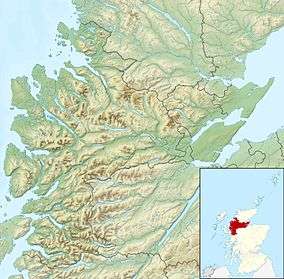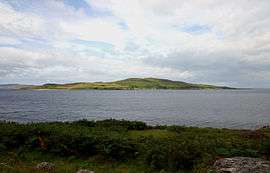Gruinard Island
Gruinard Island (/ˈɡrɪnjərd/ GRIN-yərd;[6] Scottish Gaelic: Eilean Ghruinneard) is a small, oval-shaped Scottish island approximately 2 kilometres (1.2 mi) long by 1 kilometre (0.6 mi) wide, located in Gruinard Bay, about halfway between Gairloch and Ullapool.[7] At its closest point to the mainland it is about 1 kilometre (0.6 mi) offshore. The island was dangerous for all mammals after experiments with the anthrax bacterium in 1942, until it was decontaminated in the late 20th century.
| Gaelic name | Eilean Ghruinneart |
|---|---|
| Norse name | Grunnfjörðr |
| Meaning of name | "Shallow firth", from Norse |
| Location | |
 Gruinard Island Gruinard Island shown within Ross and Cromarty | |
| OS grid reference | NG945945 |
| Coordinates | 57.89°N 05.47°W |
| Physical geography | |
| Island group | Inner Hebrides/Islands of Ross and Cromarty |
| Area | 196 hectares (0.76 sq mi) |
| Area rank | 111 [1] |
| Highest elevation | An Eilid 106 metres (348 ft) |
| Administration | |
| Sovereign state | United Kingdom |
| Country | Scotland |
| Council area | Highland |
| Demographics | |
| Population | 0[2] |
| Population rank | 0 [1] |
| Largest settlement | None |
| References | [3][4][5] |
Early history
The island was mentioned by Dean Munro who travelled the area in the mid-16th century. He wrote that it was Clan MacKenzie territory, was "full of woods", (a striking comparison with its treelessness today) and that it was "guid for fostering of thieves and rebellis",[8] meaning good for fostering thieves and rebels.
The population was recorded as six in 1881, but Gruinard has been uninhabited since the 1920s.[3]
Biological warfare testing
In 1942, during the Second World War, a biological warfare test was carried out on Gruinard by British military scientists from the Biology Department of Porton Down.[9] The British government was investigating the feasibility of a bioweapons attack using anthrax.[10] It was recognised that tests would cause long-lasting contamination of the immediate area by anthrax spores, so a remote and uninhabited island was required. Gruinard was surveyed, deemed suitable, and requisitioned from its owners by the British Government.[11] Porton Down meteorologist Sir Oliver Graham Sutton was put in charge of a fifty-man team to conduct the trial, with David Henderson in charge of the germ bomb. Biology Department head Paul Fildes made frequent visits.[12]
The anthrax strain chosen was a highly virulent type called "Vollum 14578", named after R. L. Vollum, Professor of Bacteriology at the University of Oxford, who supplied it.[13] Eighty sheep were taken to the island and bombs filled with anthrax spores were exploded close to where selected groups were tethered. The sheep became infected with anthrax and began to die within days of exposure.[9]
Some of the experiments were recorded on 16 mm colour movie film, which was declassified in 1997. One sequence shows the detonation of an anthrax bomb fixed at the end of a tall pole supported with guy ropes. After the bomb explodes, a brownish aerosol cloud drifts away towards the target animals. A later sequence shows anthrax-infected sheep carcasses being burned in incinerators at the end of the experiment.[14]
After the tests were completed, scientists concluded that a large release of anthrax spores would thoroughly pollute German cities, rendering them uninhabitable for decades afterwards.[9] Those conclusions were supported by the inability to decontaminate the island after the experiment—the spores were sufficiently durable to resist any efforts at decontamination.
In 1945, when the island's owner sought its return, the Ministry of Supply recognised that the island was contaminated, and so could not be de-requisitioned until it was deemed safe. In 1946, the government agreed to acquire the island and to take responsibility for it. The owner or her heirs would be able to repurchase the island for £500 when it was declared "fit for habitation by man and beast".
For many years, it was judged too hazardous and expensive to decontaminate the island sufficiently to allow public access, and Gruinard Island was quarantined indefinitely. Visits to the island were prohibited, except for periodic checks by Porton Down personnel to determine the level of contamination.[15]
Operation Dark Harvest
In 1981 newspapers began receiving messages with the heading "Operation Dark Harvest" which demanded that the government decontaminate the island, and reported that a "team of microbiologists from two universities" had landed on the island with the aid of local people and collected 300 lb (140 kg) of soil.
The group threatened to leave samples of the soil "at appropriate points that will ensure the rapid loss of indifference of the government and the equally rapid education of the general public". The same day a sealed package of soil was left outside the military research facility at Porton Down; tests revealed that it contained anthrax bacilli. A few days later another sealed package of soil was left in Blackpool, where the ruling Conservative Party was holding its annual conference. The soil did not contain anthrax, but officials said that the soil was similar to that found on the island.[16]
Decontamination
Starting in 1986 a determined effort was made to decontaminate the island: 280 tonnes of formaldehyde solution diluted in sea water was sprayed over all 196 hectares of the island and the worst-contaminated topsoil around the dispersal site was removed. A flock of sheep was then placed on the island and remained healthy.
On 24 April 1990, after 48 years of quarantine and four years after the solution was applied, junior defence minister Michael Neubert visited the island and announced its safety by removing the warning signs.[9] On 1 May 1990, the island was repurchased by the heirs of the original owner for the original sale price of £500.[11]

Popular culture references
The island is mentioned in the novels The Anthrax Mutation by Alan Scott (1971), The Enemy by Desmond Bagley (1977), Sea of Death by Richard P. Henrick (1992), The Fist of God by Frederick Forsyth (1994), Quantico by Greg Bear (2005), The Big Over Easy by Jasper Fforde (2005), Forbidden Island by Malcolm Rose (2009), And then you die by Iris Johansen (1998), The Island by R J Price (better-known as the poet Richard Price) (2010) and The Impossible Dead by Ian Rankin (2011). It also features as the principal setting for the novel El año de gracia by Cristina Fernández Cubas, in which the protagonist spends a winter shipwrecked on the island.[17]
In issues 187–188 of the comic book Hellblazer, in a story titled "Bred in the Bone", the protagonist's niece finds herself on Gruinard surrounded by flesh-eating children. The issues were released in 2003 and were written by Mike Carey and illustrated by Doug Alexander Gregory.
An episode of the British wartime TV series Foyle's War entitled "Bad Blood" involved biological testing – a strong reference to the Gruinard testing.
The Hawaii Five-O episode "Three Dead Cows at Makapu, Part 2" featured a scientist played by Ed Flanders who threatened to unleash a deadly virus on the island of Oahu. When being interrogated, the scientist briefly mentions Gruinard Island and how it will be uninhabitable for a century due to anthrax experiments.
Outlying Islands, a Fringe First winning play by Scottish dramatist David Greig, is a fictionalised account of two British scientists' visit to an island in Scotland where the government plans to test anthrax inspired by the story of Gruinard.[18]
The 2013 UK TV series Utopia describes the fictional outbreak of a new form of flu. During Episode 3, Dugdale visits the proposed origin of the virus at the, now quarantined, Island of Fetlar. On arrival, personnel at the Island, wearing orange overalls, carry one of numerous covered bodies past on a stretcher in a scene that is nearly identical to that seen in the original test footage from Gruinard Island. In the dramatisation however, the personnel at Fetlar are seen wearing dust masks as opposed to the gas masks seen in the Gruinard footage; likely due to budget constraints (much of Utopia was not filmed where it claims to be).[14]
The experiments are referred to in the storyline of 'Trust', the third and fourth episodes of Series 16 of the BBC series Silent Witness.[19]
Footnotes
- Area and population ranks: there are c. 300 islands over 20 ha in extent and 93 permanently inhabited islands were listed in the 2011 census.
- National Records of Scotland (15 August 2013) (pdf) Statistical Bulletin: 2011 Census: First Results on Population and Household Estimates for Scotland - Release 1C (Part Two). "Appendix 2: Population and households on Scotland’s inhabited islands". Retrieved 17 August 2013.
- Haswell-Smith (2004) p. 187
- Ordnance Survey. OS Maps Online (Map). 1:25,000. Leisure.
- Mac an Tàilleir, Iain (2003) Ainmean-àite/Placenames. (pdf) Pàrlamaid na h-Alba. Retrieved 26 August 2012.
- G.M. Miller, BBC Pronouncing Dictionary of British Names (London: Oxford UP, 1971), p. 65.
- United States National Research Council (2005). Reopening Public Facilities After a Biological Attack: A Decision-Making Framework. Washington, D.C.: National Academies Press. p. 196. doi:10.17226/11324. ISBN 978-0-309-09661-4.
- Monro (1549) "Gruynorde" no. 178
- Britain's 'Anthrax Island', 25 July 2001 news.bbc.co.uk, accessed 5 March 2020
- Living with anthrax island, BBC, 'In 1942 it became the focus of the UK's secret effort to find a weapon capable of defeating the Nazis.', '"I understand Winston Churchill was very keen on using anthrax," says local historian Donald McIntyre. "He didn't see why the devil should have all the best weapons."' 8 November 2001 news.bbc.co.uk, accessed 5 March 2020
- Pearson, Dr. Graham S. (October 1990) "Gruinard Island Returns to Civil Use " The ASA Newsletter. Applied Science and Analysis. Inc. Retrieved 12 January 2008.
- Guillemin, Jeanne. Biological Weapons. p. 54.
- United States exports of biological materials to Iraq: Compromising the credibility of international law Archived 6 February 2012 at the Wayback Machine, Geoffrey Holland, University of Sussex, 'Anthrax was the weapon of choice and between 1942 and 1943 [Dr Paul Fildes'] team from Porton Down took over the remote Scottish island of Gruinard, where they detonated a series of anthrax-laden bombs, testing their killing efficiency using sheep', 'Dr Fildes obtained this anthrax from Prof R L Vollum – Professor of Bacteriology at Oxford University',
- Anthrax Island (video) www.sonicbomb.com, accessed 5 March 2020
- National Archives file WO 188/2783 "Gruinard Island following contamination by anthrax: annual inspections; correspondence"
- "Dark Harvest". Time Magazine. 9 November 1981. Retrieved 1 February 2008.
- Fernández Cubas, Cristina. El año de gracia. Originally published in 1985. Tusquets Editores, ISBN 978-8-47223-750-6
- "Atticist to Bring Outlying Islands to King's Head Theatre". theatreweekly.com. Retrieved 22 November 2018.
- "BBC One - Silent Witness, Series 16, Trust - Episode guide". Archived from the original on 27 September 2017. Retrieved 20 August 2017.
References
- Haswell-Smith, Hamish (2004). The Scottish Islands. Edinburgh: Canongate. ISBN 978-1-84195-454-7.
- Monro, Sir Donald (1549) Description of the Western Isles of Scotland. William Auld. Edinburgh - 1774 edition.